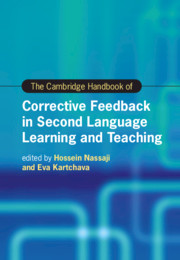Book contents
- The Cambridge Handbook of Corrective Feedback in Second Language Learning and Teaching
- Cambridge Handbooks in Language and Linguistics
- The Cambridge Handbook of Corrective Feedback in Second Language Learning and Teaching
- Copyright page
- Contents
- Figures
- Tables
- Contributors
- Acknowledgments
- Introduction Corrective Feedback in Second Language Teaching and Learning
- Part I Theoretical Perspectives on Corrective Feedback
- Part II Methodological Approaches in the Study of Corrective Feedback
- Part III Different Delivery Modes of Corrective Feedback
- Part IV Feedback Provider, Feedback Intensity, and Feedback Timing
- 13 Peer Feedback in Second Language Oral Interaction
- 14 Focused versus Unfocused Corrective Feedback
- 15 Corrective Feedback Timing and Second Language Grammatical Development: Research, Theory, and Practice
- 16 Explicit and Implicit Oral Corrective Feedback
- Part V Corrective Feedback and Language Skills
- Part VI Contexts of Corrective Feedback and Their Effects
- Part VII Learners’ and Teachers’ Feedback Perspectives, Perceptions, and Preferences
- Part VIII Individual Differences, Tasks, and Other Language- and Learner-Related Factors
- Index
- References
16 - Explicit and Implicit Oral Corrective Feedback
from Part IV - Feedback Provider, Feedback Intensity, and Feedback Timing
Published online by Cambridge University Press: 26 February 2021
- The Cambridge Handbook of Corrective Feedback in Second Language Learning and Teaching
- Cambridge Handbooks in Language and Linguistics
- The Cambridge Handbook of Corrective Feedback in Second Language Learning and Teaching
- Copyright page
- Contents
- Figures
- Tables
- Contributors
- Acknowledgments
- Introduction Corrective Feedback in Second Language Teaching and Learning
- Part I Theoretical Perspectives on Corrective Feedback
- Part II Methodological Approaches in the Study of Corrective Feedback
- Part III Different Delivery Modes of Corrective Feedback
- Part IV Feedback Provider, Feedback Intensity, and Feedback Timing
- 13 Peer Feedback in Second Language Oral Interaction
- 14 Focused versus Unfocused Corrective Feedback
- 15 Corrective Feedback Timing and Second Language Grammatical Development: Research, Theory, and Practice
- 16 Explicit and Implicit Oral Corrective Feedback
- Part V Corrective Feedback and Language Skills
- Part VI Contexts of Corrective Feedback and Their Effects
- Part VII Learners’ and Teachers’ Feedback Perspectives, Perceptions, and Preferences
- Part VIII Individual Differences, Tasks, and Other Language- and Learner-Related Factors
- Index
- References
Summary
This chapter begin with a general definition of implicit and explicit CF and the classification of common CF strategies accordingly. However, emphasis is placed on the fact the individual strategies can vary in their degree of implicitness and explicitness and also in terms of whether they are input-providing or output-prompting. The significance of both cognitive-interactionist and sociocultural theories for predicting the effectiveness of implicit and explicit CF is considered next. The bulk of the chapter reviews the results of research, starting with meta-analyses of CF studies and then moving on to consider descriptive classroom-based studies and comparative experimental studies. Recasts (which can vary markedly in how implicit or explicit they are) have been found to be the most popular type of teacher feedback strategy but not in every context. Explicit CF results in higher levels of repair of errors. However, because of the numerous factors that affect the impact that CF has on acquisition (for example, whether or not noticing occurs, the grammatical target of the correction, and the intensity of the correction), it is not surprising that the results of the research are quite mixed and it is not possible to say which type of feedback is overall the more effective. The chapter concludes with some tentative generalizations and a plea for longitudinal studies of implicit/ explicit CF.
Keywords
Information
- Type
- Chapter
- Information
- The Cambridge Handbook of Corrective Feedback in Second Language Learning and Teaching , pp. 341 - 364Publisher: Cambridge University PressPrint publication year: 2021
References
Accessibility standard: Unknown
Why this information is here
This section outlines the accessibility features of this content - including support for screen readers, full keyboard navigation and high-contrast display options. This may not be relevant for you.Accessibility Information
- 6
- Cited by
